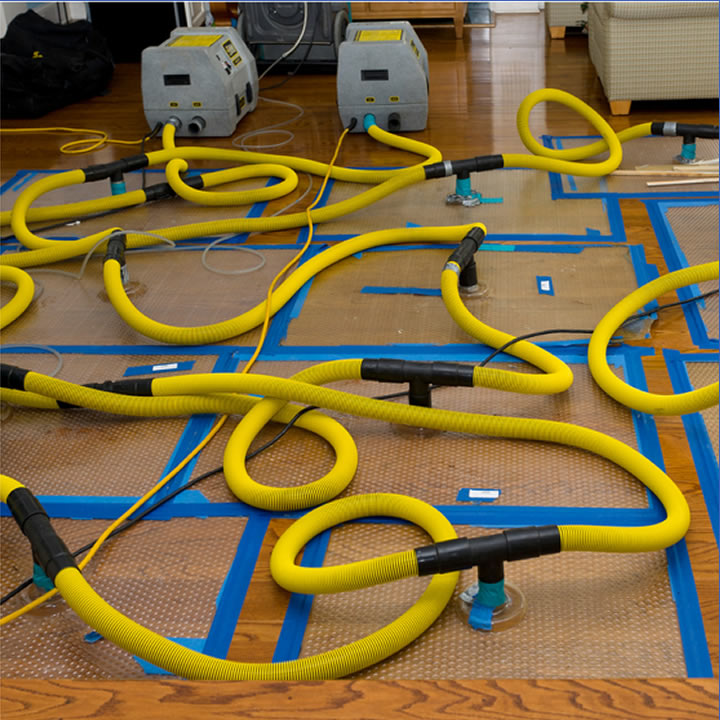The water that gets into your home can cause severe destruction to your home and your items. Drying insufficiently, water extraction or decontamination could have serious long-term consequences.
This can result in structural damage, as well as health hazards. The insurance company also requires you to reduce the damage caused by water. If you fail to comply, it could alter the amount of the insurance claim. Keep reading to learn more!
The process of removing and repairing is based on the degree of the water damage and the length of time since the floodwaters soaked your home.
Based on the information provided above, It is crucial to inform your insurance company immediately and begin the remediation of the water damage as quickly as possible.
Water Damage Mitigation Process
Companies that deal with water damage typically use seven steps to complete the process:
Initial Check
Restoration companies that deal with water damage usually begin with an evaluation and inspection of the damage to identify the necessary actions before the restoration process begins.
Reduce and limit the impact of water damage
The restoration of water damage will determine the cause of the damage. They aim to prevent any further damage. This could mean cutting off the power and the water source (for security reasons).
Following is clearing the water that is standing. However, before beginning the process, they must remove all wet carpets, clothing, and furniture in the affected area. This improves the likelihood of successfully mitigating water damage and improving the efficiency of the process.
The drying and removal of water
The most popular methods for removing standing water are buckets and mops, towels, water-powered vacuum cleaners, humidifiers, fans, and opening windows that permit air circulation to accelerate drying.
For more information, continue reading the article.
Remove areas damaged by water
After you have cleared the standing water, it’s time to remove items that were damaged by water. Photograph damaged objects before removing them. This will keep a record of the damage to help with insurance.
Removing damaged areas like ceilings, drywall, and floors may be necessary if they’re filled with water. If you do not take care of removing them, they could cause the growth of mould that could take over your entire home and put you at risk for health.
Clean, disinfect, and then remove the odour
Cleaning or disinfecting items can keep their items from getting destroyed, minimize health risks, and eliminate foul odours.
Post-job surveillance
It monitors the job after completion during the drying process, including inspections to determine mould development. This will ensure that your property is maintained to an excellent standard and that no further mitigation measures are required to deal with water damage.
Reconstruction, repairs, and reconstruction
Once the structure is dry, you can repair structural damage and substitute for different construction materials.
Water Damage Mitigation Checklist
If your house is ravaged by water If your home is suffering from water damage, follow these steps:
- Contact your insurance provider.
- Call a plumber to fix the issues you need.
- Contact a reliable restoration service to repair water damage.
- Find out what caused the issue.
- Shut off the water supply (if needed).
- Switch off the power in the affected area.
- Furniture drawers, open doors, and closet doors that let air flow.
- Let the airflow through your windows.
Use a fan to help circulate the air and help in drying (only after you’ve confirmed there’s no asbestos or lead in the construction materials).
- Be sure draperies are not straying from the floor.
- Take care to get rid of as much standing water as you can.
- Use sponges, rags, and towels to absorb water.
- Wipe furniture dry.
- Remove books wet off the shelves, then compress them so they don’t shift.
- Secure your valuables, photographs, documents, artworks, and other personal belongings in a secure location and dry.
Get rid of the room’s wet rugs, furniture, and other materials.
- Take pictures of the water damage to assist with insurance claims.
If your home is a victim of water damage, don’t:
- Check the condition of a room with running water when electricity is used.
- Make your cleaning and remove any mould that may be present to make repairs.
- Clean the water using a standard household vacuum.
- Utilize electrical or electronic devices while you are close to wet carpets or flooring.
- Relax on a sagging or ceiling that is water-logged.
Which Is the Right Water Damage Restoration Company?
Businesses that provide water restoration are not required to be licensed or accredited to restore water-related damages in California.
Furthermore, they do not require a license from the Contractors State License Board – section 7048 provides the exemption of licensure for tasks that are not considered minor if the contract’s total price, including labour and materials, is less than $500.
This exclusion isn’t granted in the case of work that is part of an overall project.
It is reasonable to believe that the Contractors State License Board regulates trustworthy, established, and well-established restoration companies that deal with water damage. A permit to be a contractor does not imply that they’re experts in the repair of water-related damage.
They must be certified by an organization known as”the Institute of Inspection, Cleaning, and Restoration Certification (IICRC). While it’s not a legal obligation to be certified in California, the IICRC gives certification to a Water Damage Restoration Technician (WRT) certification.
According to the IICRC, this certificate “demonstrates the ability to perform remediation and the ability to comprehend impacts of water damage as well as the methods used to dry up structures.”
Based on this, consider asking your restoration company about water damage to verify if they’re accredited by the Contractors State License Board and recognized through the Institute of Inspection, Cleaning, and Restoration. If they need to be certified, we suggest you hire another business.

